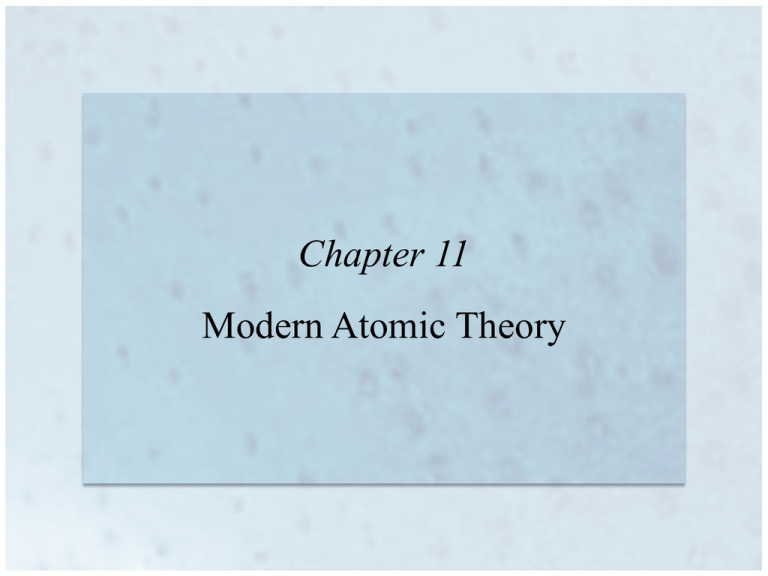
Chapter 11
Modern Atomic Theory
Rutherford’s Atom
• The concept of a nuclear atom (charged
electrons moving around the nucleus)
resulted from Ernest Rutherford’s
experiments.
• Question left unanswered: how are electrons
arranged and how do they move?
Copyright © Houghton Mifflin Company. All rights reserved.
11 | 2
Rutherford’s Atom (cont.)
Copyright © Houghton Mifflin Company. All rights reserved.
11 | 3
Electromagnetic Radiation
• Electromagnetic radiation is given off by atoms when
they have been excited by any form of energy, as
shown in flame tests.
• Flame tests:
Sample: Color:
LiCl
SrCl2
NaCl
KCl
CaCl2
Copyright © Houghton Mifflin Company. All rights reserved.
11 | 4
Electromagnetic Waves
• Velocity = c = speed of light
– 2.997925 x 108 m/s
– All types of light energy travel at the same speed.
• Amplitude = A = measure of the intensity of the
wave, i.e.“brightness”
Copyright © Houghton Mifflin Company. All rights reserved.
11 | 5
Electromagnetic Waves (cont.)
• Wavelength = = distance between two
consecutive peaks or troughs in a wave
– Generally measured in nanometers (1 nm = 10-9 m)
– Same distance for troughs
• Frequency = = the number of waves that pass
a point in space in one second
– Generally measured in Hertz (Hz),
– 1 Hz = 1 wave/sec = 1 sec-1
• c=x
Copyright © Houghton Mifflin Company. All rights reserved.
11 | 6
Types of Electromagnetic Radiation
Copyright © Houghton Mifflin Company. All rights reserved.
11 | 7
Planck’s Discovery
• Showed that for certain applications light energy
could be thought of as particles or photons
Copyright © Houghton Mifflin Company. All rights reserved.
11 | 8
Emission of Energy by
Atoms/Atomic Spectra
• Atoms that have gained extra energy release that
energy in the form of light.
Copyright © Houghton Mifflin Company. All rights reserved.
11 | 9
Atomic Spectra
• Line spectrum: very specific wavelengths of light that
atoms give off or gain
• Each element has its own line spectrum, which can be used
to identify that element.
• This is the basis of atomic absorption spectroscopy.
Copyright © Houghton Mifflin Company. All rights reserved.
11 | 10
Atomic Spectra (cont.)
• Hydrogen atoms have several excited state energy levels.
• Different colors are produced when the excited atoms return to the
ground state.
• The line spectrum of hydrogen must be related to energy changes in the
atom.
Copyright © Houghton Mifflin Company. All rights reserved.
11 | 11
Atomic Spectra (cont.)
• The atom is quantized, i.e. only certain energies
are allowed.
Continuous levels
Copyright © Houghton Mifflin Company. All rights reserved.
Quantized levels
11 | 12
Bohr’s Model (Niel’s Bohr 1885-1911)
• Energy of the atom is quantized
– An atom can only have certain specific energy
states called quantum levels or energy levels.
– When an atom gains energy, an electron
“moves” to a higher quantum level.
– When an atom loses energy, the electron
“moves” to a lower quantum level.
– Lines in a spectrum correspond to the
difference in energy between the levels.
Copyright © Houghton Mifflin Company. All rights reserved.
11 | 13
Bohr’s Model (cont.)
• Ground state: minimum
energy of an atom
• The ground state of
hydrogen corresponds to
having its one electron in
the n=1 level
• Excited states: energy
levels higher than the
ground state
Copyright © Houghton Mifflin Company. All rights reserved.
11 | 14
Bohr’s Model (cont.)
• Distances between energy levels decrease as
the energy increases
– 1st energy level can hold 2 electrons, the 2nd
level 8 electrons, the 3rd 18 electrons, etc.
Copyright © Houghton Mifflin Company. All rights reserved.
11 | 15
Problems with the Bohr Model
• Only explains hydrogen atom spectrum (and
other 1-electron systems).
• Neglects interactions between electrons.
• Assumes circular or elliptical orbits for
electrons (which is not true).
Copyright © Houghton Mifflin Company. All rights reserved.
11 | 16
Wave Mechanical Model of the Atom
• Experiments later showed that electrons could be
treated as waves: Louis De Broglie
• The quantum mechanical model treats electrons as
waves and uses wave mathematics to calculate
probability densities of finding the electron in a
particular region in the atom.
– Schrödinger Wave Equation
Copyright © Houghton Mifflin Company. All rights reserved.
11 | 17
Orbitals and Energy Levels
• Solutions to the wave equation give regions
in space of high probability for finding the
electron. These are called orbitals.
• Each principal energy level contains one or
more sublevels. Sublevels are made up of
orbitals.
Copyright © Houghton Mifflin Company. All rights reserved.
11 | 18
Orbitals and Energy Levels (cont.)
Copyright © Houghton Mifflin Company. All rights reserved.
11 | 19
Atomic Sublevels & Orbitals
• Each type of sublevel has a different shape each and energy.
s orbital shape:
p orbital shapes:
• Each sublevel contains one or more orbitals.
Copyright © Houghton Mifflin Company. All rights reserved.
11 | 20
Atomic Sublevels & Orbitals (cont.)
Copyright © Houghton Mifflin Company. All rights reserved.
11 | 21
Pauli Exclusion Principle
• No orbital may have more than 2 electrons.
• Electrons in the same orbital must have opposite
spins.
• s sublevel holds 2 electrons (1 orbital)
• p sublevel holds 6 electrons (3 orbitals)
• d sublevel holds 10 electrons (5 orbitals)
• f sublevel holds 14 electrons (7 orbitals)
Copyright © Houghton Mifflin Company. All rights reserved.
11 | 22
Sublevels and Orbitals
n
1
2
3
4
Sublevels : Types of Orbitals (and numbers)
1s(1)
2s(1)
3s(1)
4s(1)
2p(3)
3p(3)
4p(3)
3d(5)
4d(5)
4f(7)
For a multiple-electron atom, build-up the energy levels,
filling each orbital in succession from lowest to highest.
Degenerate orbitals: orbitals with the same energy
e.g. Each p sublevel has 3 degenerate p orbitals
Copyright © Houghton Mifflin Company. All rights reserved.
11 | 23
Orbital Filling
1s
2s
3s
4s
5s
6s
7s
2p
3p
4p
5p
6p
7p
3d
4d
5d
6d
4f
5f
Therefore, the order of filling is:
Copyright © Houghton Mifflin Company. All rights reserved.
11 | 24
Electron Configurations
• For a set of degenerate orbitals, fill each
orbital half-way first before pairing the
electrons.
• Electron configurations show how many
electrons are in each sublevel of an atom –
describes where the electrons are.
- The electron configuration for a ground
state Li atom is:
- The electron configuration for a ground
state N atom is:
Copyright © Houghton Mifflin Company. All rights reserved.
11 | 25
Electron Configurations (cont)
What is the electron configuation of:
A. potassium
B. cobalt
Copyright © Houghton Mifflin Company. All rights reserved.
11 | 26
Electron Configurations (cont.)
• Valence shell: highest energy level
– Electrons in the valence shell are called valence
electrons.
– Core electrons: electrons not in the valence shell
– Often use symbol of previous noble gas in brackets to
represent core electrons:
phosphorus: 1s22s22p6 3s23p3 =
core
valence
Copyright © Houghton Mifflin Company. All rights reserved.
11 | 27
Electron Configuration
and the Periodic Table
• Elements in the same column on the
periodic table have:
– Similar chemical and physical properties
– Similar valence shell electron configurations
• same numbers of valence electrons
• same orbital types, but different energy levels
Be:
Mg:
Copyright © Houghton Mifflin Company. All rights reserved.
11 | 28
s1
1
2
3
4
5
6
7
p1 p2 p3 p4 p5
s2
p6
d1 d2 d3 d4 d5 d6 d7 d8 d9 d10
f1 f2 f3 f4 f5 f6 f7 f8 f9 f10 f11 f12 f13 f14
Copyright © Houghton Mifflin Company. All rights reserved.
11 | 29
Copyright © Houghton Mifflin Company. All rights reserved.
11 | 30
Orbital diagrams
Orbital diagrams (or box diagrams) show orbitals as boxes
grouped by sublevels with arrows representing the electrons.
Sulfur has an electron configuration of :
The orbital diagram for sulfur is:
Copyright © Houghton Mifflin Company. All rights reserved.
11 | 31
Atomic Properties and the Periodic Table
Copyright © Houghton Mifflin Company. All rights reserved.
11 | 32
Metallic Character: Metals
• Metals
– Malleable & ductile
– Shiny, lustrous
– Conduct heat and electricity
– Form cations in solution
– Lose electrons in reactions - oxidized
Copyright © Houghton Mifflin Company. All rights reserved.
11 | 33
Metallic Character: Metalloids
• Metalloids
-Also known as semi-metals
-Show some metal and some nonmetal
properties
Copyright © Houghton Mifflin Company. All rights reserved.
11 | 34
Metallic Character: Nonmetals
• Nonmetals
-Brittle in solid state
-Form anions and polyatomic anions
-Gain electrons in reactions - reduced
Copyright © Houghton Mifflin Company. All rights reserved.
11 | 35
Metallic Character (cont.)
• The ease of losing an electron varies as
follows:
Cs > Rb > K > Na > Li
• The same trend is seen in the Group 2
metals:
Copyright © Houghton Mifflin Company. All rights reserved.
11 | 36
Trend in Ionization Energy
• Minimum energy needed to remove a valence electron from
an atom in the gas phase:
M(g) → M+(g) + 1e• The lower the ionization energy, the easier it is to remove the
electron.
– Metals in general have low ionization energies and
nonmetals relatively high ones.
• Ionization energy decreases down the group.
– Valence electron is farther from the nucleus
• Ionization energy increases left to right across the period.
Copyright © Houghton Mifflin Company. All rights reserved.
11 | 37
Trend in Atomic Size
Copyright © Houghton Mifflin Company. All rights reserved.
11 | 38








